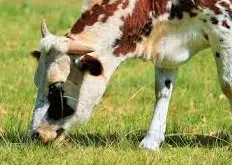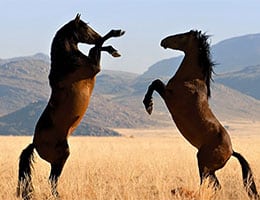 An animal whose diet is based on herbs or, in a broader sense, on vegetables in general , is classified as a herbivore . In some cases, species that are primarily herbivorous may consume some animal proteins through eggs or insects.
An animal whose diet is based on herbs or, in a broader sense, on vegetables in general , is classified as a herbivore . In some cases, species that are primarily herbivorous may consume some animal proteins through eggs or insects.
In the group of herbivorous animals, we can find granivores (they feed mainly on seeds), folivores (leaves are their main food), frugivores (focused on fruits) and xylophages (their diet is based on wood). It is important to keep in mind that many times the diet of herbivores changes during the year according to the season.
Ruminants are an example of herbivorous animals. These mammals are characterized by digestion in two steps: first they consume plants and then develop rumination, which is based on the regurgitation of semi-digested food to chew it again, add more saliva and break it down. Cows , deer , goats , and sheep are ruminants and therefore herbivores.
The trophic chain , also known as the food chain or food chain , is a flow of nutrients and energy that is created from the modes of nutrition of living beings that share an ecosystem. In it it is possible to distinguish between primary producers (beings that obtain energy from inorganic nutrients) and consumers (whose energy comes from organic nutrients). Herbivorous animals are classified as primary consumers : they ingest primary producers.
It should be noted that, if a human being decides to do without meat in their diet, they are not defined as herbivores, but are called vegetarian (if they eat plants, dairy products and eggs) or vegan (if they do not eat anything of animal origin). .
For the rest of the animals, there are other concepts that allow them to be classified according to their type of diet . Carnivores , for example, are those organisms that get the nutrients and energy they need through a diet in which meat is the only or the main product. In this group we find the predators, who directly hunt other animals and then feed on their corpses, and the scavengers, who eat the leftovers of the previous ones. In the field of ecology, the word zoophagus is preferred, which is defined as "being that feeds on animals."
 On the other hand we have omnivores , those whose diet consists of both plants and animals. They are defined as "opportunistic feeders" and also as "generalists", since they do not have an organism specifically adapted for a particular diet. In this group, to which human beings belong, we find several species, such as crows, bears, coatis, skunks and pigs.
On the other hand we have omnivores , those whose diet consists of both plants and animals. They are defined as "opportunistic feeders" and also as "generalists", since they do not have an organism specifically adapted for a particular diet. In this group, to which human beings belong, we find several species, such as crows, bears, coatis, skunks and pigs.
There are also insectivorous organisms, which feed exclusively on insects. We should not underestimate the size of the world's insect population: although they are very small individuals, they make up a considerable portion of the Earth's animal biomass .
Among the most popular herbivorous animals are the following:
* horse : these animals are admired for their beauty and presence, although they are also exploited by humans for forced labor. Both those who are fortunate enough to live in nature and those who have been enslaved feed exclusively on plants, and that is why they are considered herbivores;
* hippopotamus : although it has a very robust body and at first glance could pass for a large predator, its diet consists mainly of grass;
* iguana : this reptile has a varied diet throughout its life, since during its youth it includes small insects and in old age it becomes completely vegetarian.
